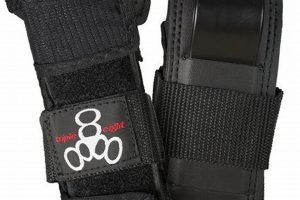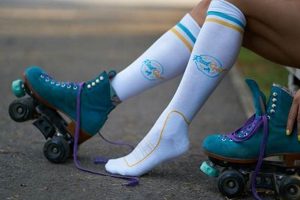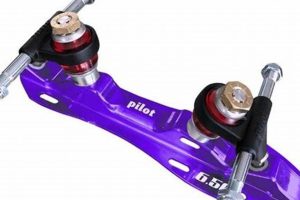Protective gear designed to mitigate impact during skateboarding activities. These items generally consist of contoured, impact-resistant plastic shells backed by energy-absorbing foam padding. Common examples include knee protectors, elbow protectors, and wrist guards.
The incorporation of these items into skateboarding practice significantly reduces the likelihood of injury from falls and collisions. This can translate to increased confidence for skaters, allowing for progression in skill development. Furthermore, this type of equipment has a history rooted in the growing awareness of safety in action sports, becoming increasingly sophisticated in design and materials over time.
The subsequent discussion will delve into the various types of protective equipment available, examining their specific features, appropriate usage, and considerations for selection based on individual needs and skating styles.
Selecting and Maintaining Impact Protection
The following guidance provides a structured approach to choosing and caring for equipment intended to minimize injury risk during skateboarding.
Tip 1: Prioritize Fit. Ill-fitting protective equipment offers diminished protection. Ensure each piece is snug but not constricting, allowing for a full range of motion without shifting during activity.
Tip 2: Evaluate Impact Rating. Consider the level of protection offered by different models. Higher impact ratings indicate greater ability to absorb force from falls or collisions. Choose equipment appropriate for the anticipated intensity of skateboarding activity.
Tip 3: Inspect Regularly for Damage. Examine each piece of equipment before each use. Look for cracks in the hard shell, tears in the padding, and any signs of wear that could compromise its integrity. Replace damaged equipment immediately.
Tip 4: Clean According to Manufacturer Instructions. Sweat and dirt can degrade materials over time. Follow the manufacturer’s recommendations for cleaning to maintain the effectiveness and lifespan of the equipment. Avoid harsh chemicals that could damage the materials.
Tip 5: Consider the Type of Skating. Different styles of skating may require different levels of protection. Aggressive skating or park skating, for example, may necessitate more robust equipment than cruising or street skating.
Tip 6: Replace After Significant Impact. Even if no visible damage is apparent, impact protection that has absorbed a significant force should be replaced. The internal structure of the equipment may be compromised, reducing its ability to protect in future incidents.
Tip 7: Store Properly. Store protective equipment in a cool, dry place away from direct sunlight. This can help prevent degradation of the materials and prolong its useful life.
Proper selection, maintenance, and consistent use of effective protection are vital for mitigating potential injuries associated with skateboarding. Adherence to these guidelines promotes safer participation in the sport.
The subsequent section will address common misconceptions surrounding safety equipment and outline strategies for promoting their adoption within the skateboarding community.
1. Impact Absorption
Impact absorption is a primary function engineered into protective gear. Specifically, pads utilize materials and designs to dissipate kinetic energy generated during falls, thereby minimizing the force transmitted to the body. The efficacy of this absorption is a critical determinant of the severity of potential injuries. A fall without protective gear results in the direct transfer of impact force to bones and soft tissues, increasing the likelihood of fractures, sprains, and contusions. These items act as a buffer, converting a high-impact force into a slower, less concentrated force.
The materials used in these pads, such as closed-cell foams and high-density plastics, play a vital role in impact absorption. The closed-cell structure of the foam allows it to compress upon impact, absorbing energy and reducing its transfer to the user’s joints. High-density plastics provide a hard outer shell, distributing the impact force over a wider area and preventing penetration. The design of the pads, including multi-layered construction and strategically placed padding, further enhances its capacity to absorb and redistribute impact. For example, a knee guard typically features a hard plastic cap over a thick layer of foam, providing both impact distribution and cushioning.
Understanding the connection between impact absorption and protective gear emphasizes their crucial role in skateboarding safety. The ability of these pads to effectively absorb and dissipate impact force is a direct determinant of injury prevention. Choosing equipment with proven impact absorption capabilities, based on material composition and design, is essential for skaters seeking to minimize the risk of injury. Proper use and maintenance of these items further ensures continued effectiveness in mitigating impact forces and promoting safer skateboarding practices.
2. Proper Fit
The efficacy of protective equipment is inextricably linked to its fit. Protection is compromised when protective gear is either too loose or too tight. Overly large items are prone to shifting during activity, exposing the skater to injury. Conversely, excessively tight items can restrict movement, impede circulation, and reduce comfort, potentially leading to decreased compliance with safety protocols. The intended protective function necessitates a fit that is snug yet allows for a full range of motion without migration or impingement. For instance, a knee pad that slides down the leg upon impact offers negligible protection to the knee joint. Similarly, a wrist guard that constricts blood flow can cause discomfort and potentially lead to numbness, discouraging its consistent use.
Achieving adequate fit involves careful consideration of sizing charts and, ideally, a physical assessment of the gear prior to use. Manufacturers provide sizing guidelines based on body measurements, which should be consulted before purchase. Furthermore, the adjustability of straps and closures is a critical factor. Protective items with adjustable features allow for a more customized fit, accommodating variations in body shape and size. The proper fit is not a static condition; it may require periodic adjustment to accommodate changes in clothing, environmental conditions, or individual body changes. It is imperative to regularly assess and adjust the fit of protective gear to ensure continued effectiveness.
In conclusion, the proper fit is not merely a matter of comfort; it is a fundamental prerequisite for the protective capability of skateboarding equipment. Ill-fitting items introduce a significant vulnerability, negating the potential benefits of the equipment. Prioritizing fit through careful measurement, assessment, and adjustment is essential for mitigating risk and promoting safer skateboarding practices.
3. Durability
Durability is a critical attribute of skateboarding protection. These pads are subjected to repetitive abrasion, impact forces, and environmental stressors. The lifespan and continued efficacy of this protective gear are directly correlated to its ability to withstand these conditions without structural failure. Substandard materials or construction techniques compromise its protective function, increasing the risk of injury. For instance, pads constructed with low-grade plastics may crack or shatter upon impact, rendering them ineffective. Similarly, stitching failures in straps or closures can lead to slippage, exposing the skater to harm. The financial cost of frequent replacements due to poor durability further underscores its importance.
Material selection and manufacturing processes are key determinants of product durability. High-density polyethylene, polypropylene, and impact-resistant nylon are commonly used in hard shell construction due to their capacity to absorb and distribute impact forces. Reinforced stitching, durable straps, and robust closure systems enhance the overall structural integrity. Furthermore, design considerations play a role. Pads with reinforced edges and strategically placed padding are less susceptible to wear and tear. The testing and certification processes employed by manufacturers provide an indication of product quality and durability. Equipment that meets or exceeds industry standards, such as those set by ASTM International, offers a greater assurance of long-term performance.
In summary, the longevity and reliability of skateboarding protective gear are directly dependent on its inherent durability. Compromises in material quality or construction directly translate to a reduced level of protection. Skaters should prioritize products manufactured with durable materials, robust construction techniques, and a demonstrated ability to withstand the rigors of skateboarding. This ensures consistent protection over time, mitigates the risk of injury, and reduces the economic burden of frequent replacements. Durability is not merely a desirable attribute; it is an essential prerequisite for effective skateboarding safety.
4. Mobility
Mobility, in the context of skateboarding protective gear, refers to the range of unrestricted motion afforded to the skater while wearing this equipment. It represents a critical design consideration, directly influencing both performance and safety. The restrictive nature of certain protection can impede a skater’s ability to execute maneuvers effectively, potentially increasing the risk of falls. Conversely, equipment that allows for a full range of movement enables precise control and responsiveness, enhancing both skill execution and the ability to react to unforeseen circumstances. For example, inflexible knee pads can hinder the bending and extension of the knee joint, essential for many skateboarding tricks, ultimately leading to instability and potential injury.
The design of effective skate pads thus necessitates a balance between protective coverage and unrestricted movement. This balance is often achieved through the use of flexible materials, strategic articulation points, and ergonomic designs that conform to the natural contours of the body. Articulated knee and elbow pads, for instance, allow for bending and straightening of the limbs without significant restriction. The use of lightweight, flexible materials such as neoprene and spandex enhances freedom of movement while maintaining a secure fit. Furthermore, strategically placed cutouts or vents can improve breathability and reduce bulk, further contributing to the overall mobility offered by the equipment. The integration of these design features enables skaters to maintain optimal control and responsiveness, reducing the risk of falls and injuries related to restricted movement.
Ultimately, mobility is not simply a matter of comfort; it is a fundamental aspect of skateboarding safety. Protective gear that restricts movement can paradoxically increase the risk of injury by hindering a skater’s ability to react effectively and maintain balance. Prioritizing equipment that strikes a balance between protection and freedom of movement is essential for maximizing safety and performance. The ongoing development of innovative materials and design techniques promises further improvements in mobility, ensuring that skaters can enjoy the sport with enhanced protection and unrestricted movement.
5. Coverage Area
Coverage area, with respect to skateboarding protection, signifies the extent to which a pad shields vulnerable anatomical regions from impact. The effectiveness of protective gear directly correlates with the magnitude of the surface area it encompasses. Inadequate coverage leaves portions of joints and limbs exposed, increasing the likelihood of injury upon contact with the ground or other objects. For instance, a knee pad that fails to extend sufficiently down the shin leaves the lower portion of the tibia vulnerable to contusions or fractures. Similarly, a wrist guard that does not adequately cover the carpal bones offers incomplete protection against sprains and breaks. Thus, comprehensive coverage is not merely a design feature; it is a functional imperative for minimizing the potential for injury.
The design of protective equipment reflects the importance of coverage area. Manufacturers strive to create pads that conform to anatomical contours, maximizing the surface area shielded while maintaining a comfortable and secure fit. Elbow pads typically extend beyond the elbow joint, covering portions of the upper arm and forearm to protect against peripheral impacts. Wrist guards often incorporate a palmar splint that extends from the base of the palm to the mid-forearm, providing rigid support and preventing hyperextension. The selection of appropriate equipment necessitates a careful evaluation of the coverage area offered, ensuring that all vulnerable regions are adequately shielded. Skaters engaged in more aggressive styles, involving higher speeds and greater risk of falls, require protection with more extensive coverage than those participating in less demanding forms of skateboarding.
In conclusion, coverage area stands as a critical determinant of the protective capacity of skateboarding equipment. Insufficient coverage compromises the integrity of the protection, rendering it less effective in mitigating injury. Prudent selection of items with adequate coverage, tailored to the specific demands of the skating style, constitutes a fundamental aspect of responsible skateboarding practice. The ongoing pursuit of improved designs and materials promises to further enhance coverage without sacrificing mobility or comfort, promoting safer participation in the sport.
6. Maintenance
The operational lifespan and protective capabilities of skateboarding equipment are intrinsically linked to consistent maintenance practices. Neglecting these pads results in a degradation of their structural integrity and a corresponding reduction in their ability to mitigate impact forces. Debris accumulation, material fatigue, and component wear are direct consequences of inadequate maintenance, undermining the skater’s safety. Abrasive particles lodged within the padding can compromise the foam’s ability to absorb energy, while unchecked corrosion or degradation of straps and closures can lead to failure during critical moments.
Effective maintenance protocols involve regular inspection, cleaning, and component replacement. Inspection routines should encompass a thorough examination of the hard shell for cracks or abrasions, assessment of padding for compression or tearing, and verification of strap and closure functionality. Cleaning procedures must adhere to the manufacturer’s recommendations, typically involving mild detergents and gentle scrubbing to remove dirt and sweat. Straps and closures exhibiting signs of wear, such as fraying or weakened Velcro, should be replaced promptly to ensure a secure fit. Ignoring minor damage invariably precipitates more substantial failures, necessitating premature replacement of entire units.
In summary, diligent maintenance constitutes an indispensable element of responsible skateboarding practice. The proactive application of inspection, cleaning, and component replacement protocols extends the operational lifespan of protection, preserves its protective efficacy, and ultimately contributes to the skater’s safety. Conversely, neglecting maintenance practices diminishes the equipment’s performance, elevates the risk of injury, and incurs greater long-term costs. Prioritizing maintenance reflects a commitment to both personal safety and responsible stewardship of protective gear.
Frequently Asked Questions
The following provides clarification on commonly encountered queries regarding skateboarding protective equipment. Understanding these points promotes informed decision-making concerning safety.
Question 1: What is the expected lifespan of skateboarding knee protectors?
The lifespan varies based on frequency of use, intensity of impact, and maintenance. Regular inspection for damage is crucial. Replacement is warranted upon significant impact or visible wear, regardless of time elapsed.
Question 2: Is it necessary to wear elbow guards when skateboarding?
Elbow injuries are common in skateboarding falls. Elbow guards are recommended, particularly for beginners or skaters attempting advanced maneuvers.
Question 3: How should sizing be determined for wrist supports?
Manufacturers provide sizing charts based on wrist circumference. Ensure a snug but not constricting fit, allowing for full finger dexterity.
Question 4: Can skateboarding protective equipment be washed?
Refer to the manufacturer’s instructions. Generally, hand washing with mild detergent and air drying is recommended. Machine washing may damage components.
Question 5: What certifications are relevant for skateboarding protective gear?
ASTM International standards are commonly cited. Certification indicates the equipment has met minimum performance requirements for impact resistance.
Question 6: Do more expensive protectors offer significantly better safety than cheaper models?
Price is not always indicative of quality. Evaluate certifications, materials, and construction. Higher-priced models may offer enhanced comfort or durability, but not necessarily superior protection.
Consistent use of properly fitted and maintained protective gear significantly reduces the risk of skateboarding-related injuries.
The next section provides information regarding the integration of protective equipment into skateboarding instruction.
Conclusion
This exploration has underscored the paramount importance of impact protection in skateboarding. From the selection and maintenance of gear to considerations of fit, durability, mobility, and coverage area, each aspect contributes to mitigating the risk of injury. Consistent application of these principles ensures the sustained efficacy of skateboarding protective equipment.
Therefore, a commitment to responsible skateboarding necessitates a prioritization of protective equipment. This commitment extends beyond mere acquisition, encompassing diligent maintenance and informed utilization. By embracing a culture of safety, the skateboarding community can foster a more sustainable and inclusive environment for practitioners of all skill levels.







